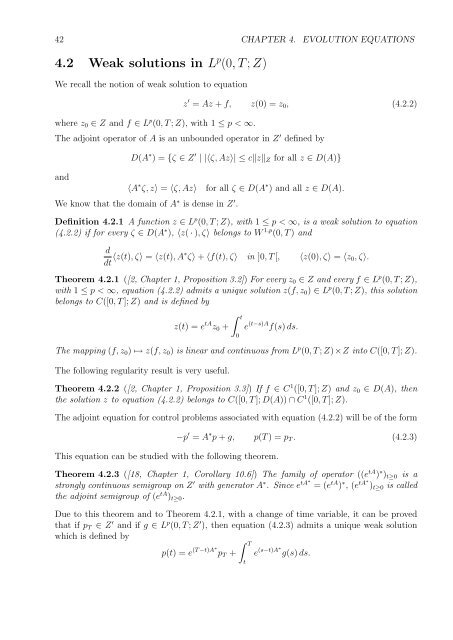Optimal Control of Partial Differential Equations
Optimal Control of Partial Differential Equations
Optimal Control of Partial Differential Equations
You also want an ePaper? Increase the reach of your titles
YUMPU automatically turns print PDFs into web optimized ePapers that Google loves.
42 CHAPTER 4. EVOLUTION EQUATIONS<br />
4.2 Weak solutions in L p (0, T ; Z)<br />
We recall the notion <strong>of</strong> weak solution to equation<br />
where z0 ∈ Z and f ∈ L p (0, T ; Z), with 1 ≤ p < ∞.<br />
z ′ = Az + f, z(0) = z0, (4.2.2)<br />
The adjoint operator <strong>of</strong> A is an unbounded operator in Z ′ defined by<br />
and<br />
D(A ∗ ) = {ζ ∈ Z ′ | |〈ζ, Az〉| ≤ czZ for all z ∈ D(A)}<br />
〈A ∗ ζ, z〉 = 〈ζ, Az〉 for all ζ ∈ D(A ∗ ) and all z ∈ D(A).<br />
We know that the domain <strong>of</strong> A ∗ is dense in Z ′ .<br />
Definition 4.2.1 A function z ∈ L p (0, T ; Z), with 1 ≤ p < ∞, is a weak solution to equation<br />
(4.2.2) if for every ζ ∈ D(A ∗ ), 〈z( · ), ζ〉 belongs to W 1,p (0, T ) and<br />
d<br />
dt 〈z(t), ζ〉 = 〈z(t), A∗ ζ〉 + 〈f(t), ζ〉 in ]0, T [, 〈z(0), ζ〉 = 〈z0, ζ〉.<br />
Theorem 4.2.1 ([2, Chapter 1, Proposition 3.2]) For every z0 ∈ Z and every f ∈ L p (0, T ; Z),<br />
with 1 ≤ p < ∞, equation (4.2.2) admits a unique solution z(f, z0) ∈ L p (0, T ; Z), this solution<br />
belongs to C([0, T ]; Z) and is defined by<br />
z(t) = e tA z0 +<br />
t<br />
0<br />
e (t−s)A f(s) ds.<br />
The mapping (f, z0) ↦→ z(f, z0) is linear and continuous from L p (0, T ; Z)×Z into C([0, T ]; Z).<br />
The following regularity result is very useful.<br />
Theorem 4.2.2 ([2, Chapter 1, Proposition 3.3]) If f ∈ C 1 ([0, T ]; Z) and z0 ∈ D(A), then<br />
the solution z to equation (4.2.2) belongs to C([0, T ]; D(A)) ∩ C 1 ([0, T ]; Z).<br />
The adjoint equation for control problems associated with equation (4.2.2) will be <strong>of</strong> the form<br />
This equation can be studied with the following theorem.<br />
−p ′ = A ∗ p + g, p(T ) = pT . (4.2.3)<br />
Theorem 4.2.3 ([18, Chapter 1, Corollary 10.6]) The family <strong>of</strong> operator ((etA ) ∗ )t≥0 is a<br />
strongly continuous semigroup on Z ′ with generator A∗ . Since etA∗ = (etA ) ∗ , (etA∗ the adjoint semigroup <strong>of</strong> (e<br />
)t≥0 is called<br />
tA )t≥0.<br />
Due to this theorem and to Theorem 4.2.1, with a change <strong>of</strong> time variable, it can be proved<br />
that if pT ∈ Z ′ and if g ∈ L p (0, T ; Z ′ ), then equation (4.2.3) admits a unique weak solution<br />
which is defined by<br />
T<br />
(T −t)A∗<br />
p(t) = e pT + e<br />
t<br />
(s−t)A∗<br />
g(s) ds.

















